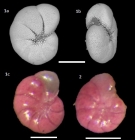WoRMS taxon details
Haynesina Banner & Culver, 1978
112163 (urn:lsid:marinespecies.org:taxname:112163)
accepted
Genus
Nonionina germanica Ehrenberg, 1840 accepted as Haynesina germanica (Ehrenberg, 1840) (type by original designation)
- Species Haynesina anglica (Murray, 1965)
- Species Haynesina depressula (Walker & Jacob, 1798)
- Species Haynesina germanica (Ehrenberg, 1840)
- Species Haynesina maeotica Maisuradze, 1988 †
- Species Haynesina magna Levchuk, 1987 †
- Species Haynesina orbicularis (Brady, 1881)
- Species Haynesina paucilocula (Cushman, 1944)
- Species Haynesina albiumbilicatula (Weiss, 1954) accepted as Cribroelphidium albiumbilicatum (Weiss, 1954) (Genus transfer)
- Species Haynesina eltigenica Yanko, 1989 † (unaccepted > unavailable name, Unpublished Ph.D. thesis (ICZN Art. 9.12), the "publication" in 2022 does not satisfy the provision of ICZN art. 16.1)
- Species Haynesina orbiculare (Brady, 1881) accepted as Haynesina orbicularis (Brady, 1881) (Genus is feminine)
- Species Haynesina paralium (Tintant, 1954) accepted as Protelphidium paralium (Tintant, 1954) (unaccepted > superseded combination)
marine, brackish, fresh, terrestrial
recent + fossil
feminine
Banner, F. T.; Culver, S. J. (1978). Quaternary Haynesina n. gen. and Paleogene Protelphidium Haynes; their morphology, affinities and distribution. <em>The Journal of Foraminiferal Research.</em> 8(3): 177-207., available online at https://doi.org/10.2113/gsjfr.8.3.177
page(s): p. 184 [details] Available for editors [request]
[request]
page(s): p. 184 [details] Available for editors
Hayward, B.W.; Le Coze, F.; Vachard, D.; Gross, O. (2025). World Foraminifera Database. Haynesina Banner & Culver, 1978. Accessed through: World Register of Marine Species at: https://www.marinespecies.org/aphia.php?p=taxdetails&id=112163 on 2025-05-07
Date
action
by
2006-09-13 06:47:38Z
changed
Martinez, Olga
![]() The webpage text is licensed under a Creative Commons
Attribution 4.0 License
The webpage text is licensed under a Creative Commons
Attribution 4.0 License
Nomenclature
original description
Banner, F. T.; Culver, S. J. (1978). Quaternary Haynesina n. gen. and Paleogene Protelphidium Haynes; their morphology, affinities and distribution. <em>The Journal of Foraminiferal Research.</em> 8(3): 177-207., available online at https://doi.org/10.2113/gsjfr.8.3.177
page(s): p. 184 [details] Available for editors [request]
[request]
basis of record Gross, O. (2001). Foraminifera, <B><I>in</I></B>: Costello, M.J. <i>et al.</i> (Ed.) (2001). <i>European register of marine species: a check-list of the marine species in Europe and a bibliography of guides to their identification. Collection Patrimoines Naturels,</i> 50: pp. 60-75 (look up in IMIS) [details]
page(s): p. 184 [details] Available for editors
basis of record Gross, O. (2001). Foraminifera, <B><I>in</I></B>: Costello, M.J. <i>et al.</i> (Ed.) (2001). <i>European register of marine species: a check-list of the marine species in Europe and a bibliography of guides to their identification. Collection Patrimoines Naturels,</i> 50: pp. 60-75 (look up in IMIS) [details]
Taxonomy
taxonomy source
Holzmann, M.; Pawlowski, J. (2017). An updated classification of rotaliid foraminifera based on ribosomal DNA phylogeny. <em>Marine Micropaleontology.</em> , available online at https://doi.org/10.1016/j.marmicro.2017.04.002
note: Genetic basis for family placement [details] Available for editors [request]
[request]
note: Genetic basis for family placement [details] Available for editors
Other
additional source
Neave, Sheffield Airey. (1939-1996). Nomenclator Zoologicus vol. 1-10 Online. <em>[Online Nomenclator Zoologicus at Checklistbank. Ubio link has gone].</em> , available online at https://www.checklistbank.org/dataset/126539/about [details]
additional source Loeblich, A. R.; Tappan, H. (1987). Foraminiferal Genera and their Classification. Van Nostrand Reinhold Company, New York. 970pp., available online at https://books.google.pt/books?id=n_BqCQAAQBAJ [details] Available for editors [request]
[request]
additional source Loeblich, A. R.; Tappan, H. (1987). Foraminiferal Genera and their Classification. Van Nostrand Reinhold Company, New York. 970pp., available online at https://books.google.pt/books?id=n_BqCQAAQBAJ [details] Available for editors
 Present
Present  Inaccurate
Inaccurate  Introduced: alien
Introduced: alien  Containing type locality
Containing type locality
From editor or global species database
Diagnosis Test planispiral, at least in the adult, involute, biumbilicate, with narrow depressed umbilici, about eight to ten chambers per whorl, enlarging gradually as added, chamber walls bend inward posteriorly and fuse to the preceding septal face, forming narrow intercameral lacunae along the septa, intercameral sutures radial, gently curved, deeply incised near the umbilicus, no rotaliid septa] flaps or toothplates, no septal or radial canals, and no retral processes or fossettes, periphery broadly rounded; wall calcareous, perforate, of optically radial but morphologically granular calcite, tubercles prominently developed around the aperture, along the intercameral sutures and over the umbilicus; primary aperture a low and symmetrical interiomarginal arch but may be obscured by abundant surface pustules, intercameral foramen similar but may be enlarged by resorption, internally an interiomarginal supplementary aperture connects the intercameral lacunae to the following chamber lumen, or supplementary areal apertures may connect the lacunae to both preceding and following chambers. U. Pliocene (Astian) to Holocene; England; Wales; Ireland; North Sea; France; Netherlands; Denmark; Norway; Germany; Turkey; Siberia; USA: off New York, Massachusetts. (Loeblich & Tappan, 1987, Foraminiferal Genera and Their Classification) [details]




